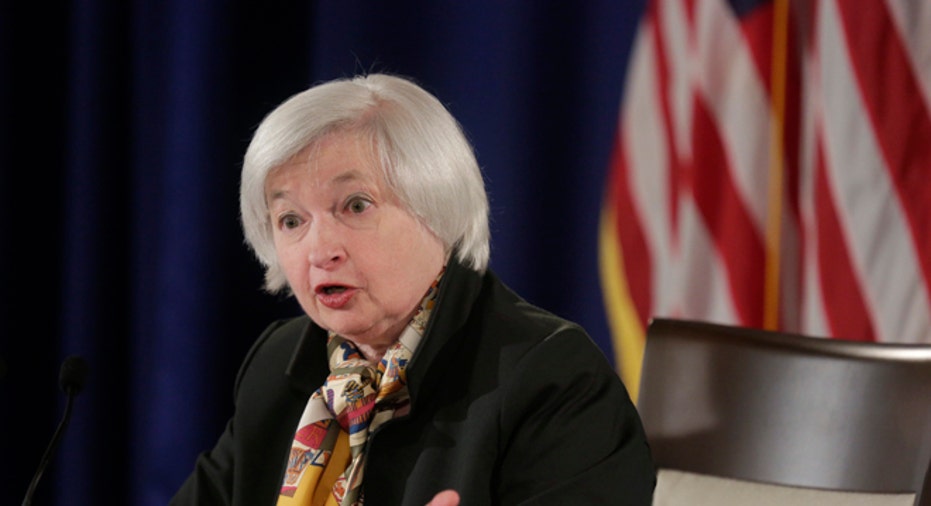The Fed is Thinking of Patience But Not Saying It

Students of Federal Reserve rhetoric will have their hands full this week trying to determine whether U.S. central bankers intend to raise interest rates sooner or later.
A weak economic patch during the first quarter has many analysts thinking the Fed is likely leaning toward later.
The reality is that the Fed members themselves remain uncertain as to the exact timing of liftoff, a point they’ve acknowledged many times, saying any future shift in monetary policy will be determined by incoming economic data.
Even so, the policy setting Federal Open Markets Committee has attempted to provide guidance to markets regarding when and how they are most likely to start raising the cost of borrowing. With that in mind, the Fed said conclusively at its March meeting that rates would not be moving higher at the April meeting, so investors and other market participants can be certain no significant policy shifts will be announced this week.
The FOMC meets for two days starting Tuesday and will release a policy statement at the conclusion of Wednesday’s meeting.
It’s widely believed that the FOMC will address the first-quarter economic weakness by hinting that a rate hike may be more likely either later in 2015 or postponed until 2016.
All About the Message
Earlier this year, as labor markets seemed to be hitting their stride after a strong finish to 2014 and inflation appeared poised to climb higher based on the tightening job market, a mid-2015 hike seemed likely. But the weak first quarter, emphasized by a surprisingly soft March labor report, has shifted that thinking toward a delay.
Analysts at Bank of America, like many other Fed watchers, believe the April statement will be more dovish (that is leaning toward keeping rates low for a while longer) than the March report, but that FOMC members will be reluctant to rule out a June hike in order to maintain flexibility in their decision-making process.
At the March meeting the Fed removed the word ‘patient’ from its statement, eliminating a rhetorical barrier to liftoff. At this point it’s all about the message and how the Fed communicates that message.
Referring to the April statement, BofA analysts Michael S. Hanson and Brian Smedley said in a research note, “The FOMC will need to make some potentially important changes in policy communications.”
The analysts explained that this week’s statement will likely acknowledge the weak first quarter, but blame it on “transitory factors” such as another harsh winter. That position fits with the FOMC members’ belief that the economy is still heading toward the Fed’s dual mandate of full employment and stable prices, defined as an unemployment rate of 5.2%-5.6% and inflation at around 2%.
In addition, the BofA analysts expect central bankers to adjust the statement language, possibly calling for a “gradual normalization” of policy, while not explicitly ruling out a June rate hike, “even though the chance of liftoff then has become very low, in our view.”
“Hopefully” Later This Year
One hint that the Fed may be thinking patience despite jettisoning the word from its statement has come via influential Fed member William Dudley, president of the New York Fed and a close ally of Fed Chair Janet Yellen. Dudley seems to have been altering his message in recent weeks, suggesting a hike could come later rather than sooner.
Last week Dudley reiterated that economic performance will determine when the Fed finally raises U.S. interest rates from near zero, adding he hopes to tighten policy later this year.
“We have to see what unfolds,” Dudley said in a speech that emphasized a cautious approach that the U.S. economy will continue to expand and that inflation will lift toward the Fed’s goal. The economy still has further to go toward the central bank's dual goals of full employment and 2% inflation, he added.
The data will “hopefully” allow for a rate hike later this year, Dudley said. But “the timing of normalization remains uncertain because how the economy evolves is also uncertain,” he added.
When rates go higher so will the cost of buying big ticket items such as homes and cars, forcing some consumers to back off those purchases. It will also make it more expensive for businesses to borrow money for expansion and investment in new capital, which could impact hiring.
That’s been the reasoning for keeping rates at their historic lows for over six years that’s held sway at the Fed among the influential inflation doves on the Fed like Yellen and Dudley.



















